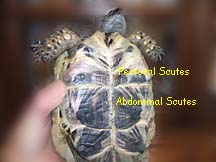Tube Feeding Guidelines
There may be occasions with an ill tortoise, when the vet has advised using an orogastric tube to replace fluids, provide food in a liquidized form, or to provide drug therapy. This technique will rehydrate the tortoise, provide nutritional support and allow for effective medication. What follows below are guidelines on how to do this at home.
This article is meant to complement the advice given to you by your vet and to remind you of the procedure already shown to you by the vet, if the tortoise is allowed home from the veterinary clinic.
Should you ever need to tube feed a tortoise, then hopefully these guidelines will be helpful in assisting you through the process which might be quite traumatic for you, but not for the tortoise, once the technique has been mastered. Two people are needed to tube feed, one to hold the tortoise comfortably and the other to insert the tube. A tortoise must be warm prior to tube feeding, so its metabolism is active in order for it to process the food.
This procedure MUST NEVER be attempted without prior veterinary advice and guidance.
For tube feeding one person should hold the tortoise in an upright position over a kitchen towel or similar to avoid any accidents.
Next the person holding the tortoise should gently rest their index fingers across the tortoise’s front legs, starting at the neck, and gently easing the legs back into the crook of the shell where they will fit nicely.
Keeping the tortoise’s front legs in this position, the fingers should be slid outwards, away from the neck of the tortoise. This will allow the second person room to manoeuvre. Then, gently but firmly, the legs should be held in this position.
The other person, who is to tube feed the tortoise, should take hold of the tortoise’s neck from above with the thumb and middle finger of one hand.
Gently lift the neck out from under the shell until the head is free from any shell protection, and then apply slight pressure just behind the jaw, so that the mouth opens. Once the tortoise’s mouth is open, slip the index finger into the side of the mouth to prevent it from closing before inserting the tube.
The tortoises’ windpipe will be seen as a tiny hole behind the tongue in the midline, which should be avoided. The vet will have provided you with a feeding tube of the correct size. Start to gently slide the tube all the way into the mouth down one side. As a guide a feeding tube should be inserted to the point of the junction between the pectoral and abdominal scutes of the plastron and there should be no resistance to passing the tube.

Be careful the tube does not become dislodged from the syringe.
When the feeding tube is in place, the plunger on the syringe should be depressed to quickly empty the liquid contents into the tortoise’s stomach.
Please note that there will be a pocket of air in between the feeding liquid and the black stopper -- this is normal.
Once the plunger has been fully depressed and all the feeding liquid/medication has been fed down the tube into the tortoise’s stomach, you should now slowly but firmly withdraw the tubing up through the digestive tract and out from the tortoise’s mouth.
Any excess liquid fed to the tortoise will overflow, indicating that the stomach/gut is full. If this is seen during plunger depression then the tube should be withdrawn immediately.
Finally, hold the tortoise in an upright position for a minute or two until the fluid settles. Place the tortoise back in its habitat and maintain warmth.
Once the procedure is completed the tube and syringe should be washed in warm soapy water and rinsed thoroughly ready for reuse.
Both carers now should wash their hands.
All rights reserved.
Copyright © 2009 Tortoise Protection Group




